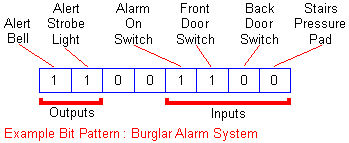2.
| A control system consists of some
sensors,
devices, an
interface, a computer and
software to control the system.
| |
| 3.
| A control system gathers data using sensors. Using an
algorithm the system will
decide when to turn devices on and off based upon the information provided by the
sensors.
| |
| 4.
| A sensor measures a physical quantity such as the temperature
and then sends a voltage to the computer representing the quantity measured.
| |
| 5.
| Example sensors are heat sensors, light sensors, pressure pads and buttons.
| |
| 6.
| A device can be used to make changes to the real world environment that a control
system operates in. Devices are also known as actuators.
| |
| 7.
| Example devices are buzzers, motors, pumps, lamps and liquid crystal displays.
| |
| 8.
An interface is positioned between the sensors and the computer. The interface
contains two important components :
- An Analogue to Digital Converter (ADC) which changes the analogue voltages
produced by the sensors into digital signals that the computer can process.
- A Digital to Analogue Converter (DAC) which changes the digital signals that
the computer produces into analogue voltages which can control the devices.
|
| 9.
| The control software uses
an algorithm to decide when to turn the devices on
and off based upon the inputs from the sensors. The algorithm is usually planned
as a flowchart and then entered into the computer using a
programming language.
| |
| 10.
| Feedback occurs when the preious outputs from a control system change the inputs, usually to keep the system in a stable state.
| |
| 11.
| Information about the current status of the sensors in a control system is often presented to a computer by the interface as a
byte of data. Each bit in the byte represents the current state of one digital sensor, with a 0 indicating the
sensor is off and a 1 indicating the sensor is on. Devices can be
activated/deactivated by the computer setting bits associated with the devices to 0 (off) or 1 (on).

| |
| 12.
Advantages of computer control systems over manual systems :
- Faster response time.
- Low operating costs (fewer wages to pay).
- Very reliable. A control system will not get tired or make mistakes.
|
| 13.
The main disadvantages of computerised control systems are :
- High initial costs of design and purchase of system and training.
- Jobs lost when new system introduced.
- System will fail if the program that controls it has not been
designed
properly. If no-one notices this then it could be dangerous.
|
| 14.
| A computerised control system that is built into another machine is known as an embedded control system. Embedded control systems can be found in burglar alarms, environmental control systems,
VCRs, refrigerators and cars amongst many other machines.
| |
| 15.
| Computer Assisted Manufacturing (CAM) is the use of computers to manufacture products. CAM systems control CNC devices such as lathes and milling machines to
make items. Often the design of the item to be made is produced in a CAD package and transferred electronically to a CAM system to be made. This is known as CAD/CAM.
| |
| 16.
| Robots are computer-controlled devices that are capable of motion and can perform a variety of tasks. Robots can be used in situations that are dangerous to humans. They can perform
repetitive tasks highly accurately. Robots allow products to be made cheaply but have caused some people to lose their jobs.
| |
| 17.
The flow of traffic around a town can be monitored and controlled by a computerised system :
- The sequence of traffic lights at a road junction can be controlled by a computerised system.
- The sequence of traffic lights at different road junctions can be co-ordinated to improve traffic flow.
- Congestion charging systems can charge drivers for the journeys they make.
- Entry to car parks and charging can be managed by a computerised system.
- Satellite Navigation (SatNav) systems can give a driver instructions to tell him how to get to his destination.
| | | | | | | | | | | | | | | | | | | |
